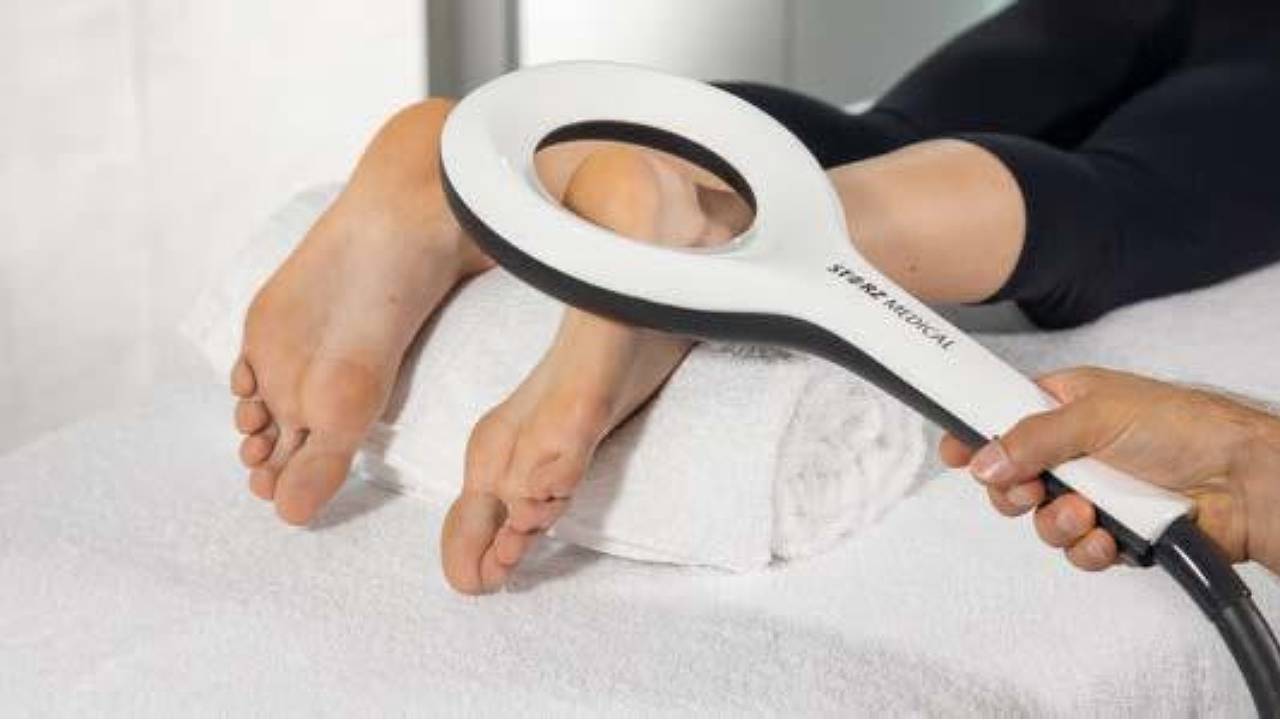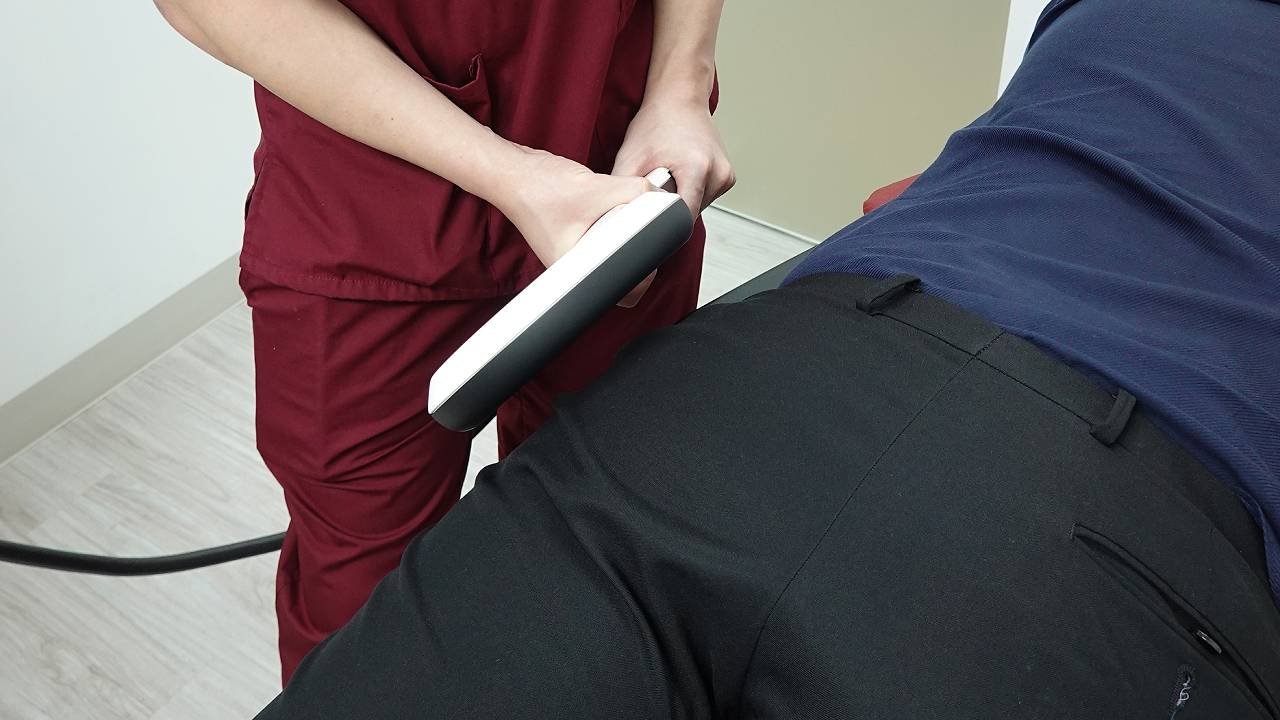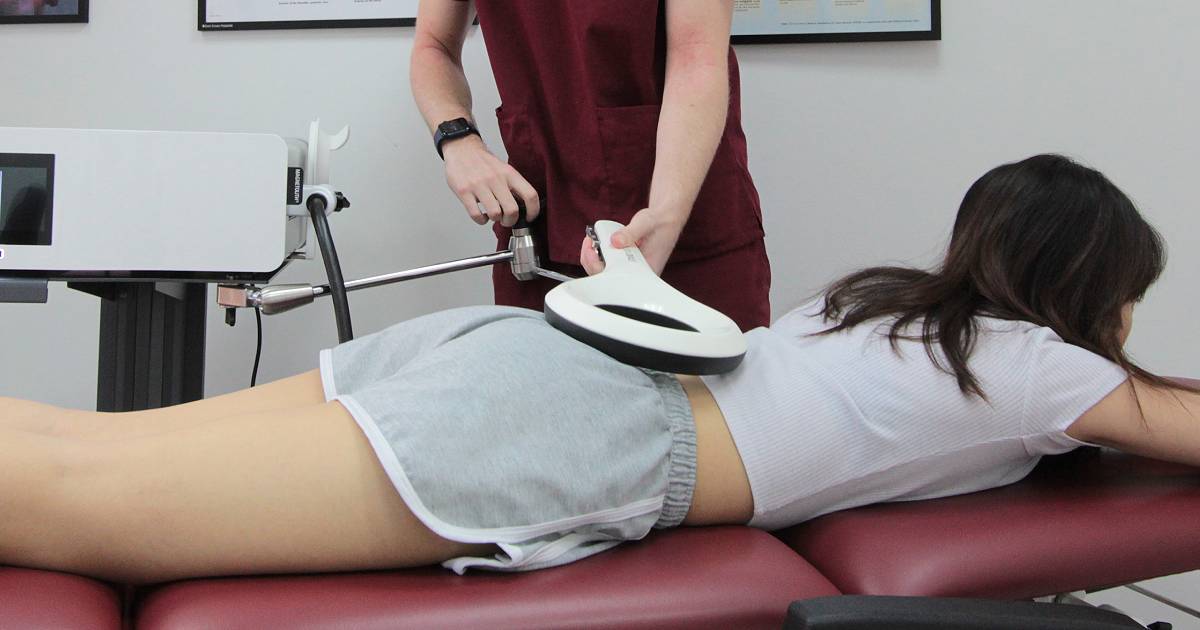Extracorporeal Magnetotransduction Therapy (EMTT) with the MAGNETOLITH is an extremely comfortable in-clinic procedure that is applied to areas of pain, swelling or degeneration without the need for a patient to expose the affected areas or to undress. It provides high oscillating frequency of 100-300 kHz into the affected area, with deep penetration of up to 18cm. This stimulates tissue regeneration deeper than most modalities available today without causing any pain or discomfort. The long-term effect is regeneration and rehabilitation of musculoskeletal conditions with a significant decrease in pain and improved function. There are no side effects nor down time meaning patients can continue with their day as normal.

EMTT addresses
- Degenerative joint diseases
Signs of wear and tear, e.g. arthrosis (knee, hip, hands, shoulder, elbow), herniated disc, spondylarthrosis. - Pain therapy
(Chronic) pain, e.g. back pain, lumbalgia, tension, radiculopathies, heel pain. - Sport injuries
Inflammation of tendons and joints, tendon overload syndrome, osteitis pubis. - Fractures and bone oedema
Including diabetic foot conditions
During the Cold War, electromagnetic fields were used by the Soviet Union to aid cosmonauts who had spent extended periods in space. These cosmonauts suffered from a loss of bone density and muscle due to the lack of gravity and exercise, returning to Earth with weakened bones and muscles. To address this, the Soviet Union would employ pulsed electromagnetic field (PEMF) therapy to supplement pharmaceutical methods in regenerating bone density and combating bone loss. The use of PEMF spread throughout the Soviet Union and Eastern Europe, and would spread to Western Europe after the fall of the Berlin Wall. In the early 2000s, NASA would conduct its own research into the use of PEMF, eventually filing its own patent for the use of PEMF in tissue regeneration.EMTT utilises those same electromagnetic fields to positively influence tissue to promote healing. Therapeutic effects include pain relief, fracture healing, muscle relaxation, nerve stimulation and joint mobilization.
EMTT is also used to address conditions of the back or spine such as ankylosing spondylitis, lumbosacral syndrome, or upper and lower back pain. Other conditions include carpal tunnel or epicondylitis, also known as tennis elbow, or non-localised conditions such as bursitis, neuralgia, fractures, spasticity, and calcification.
The equipment utilized for EMTT offers a versatile range of frequencies and adjustable power levels, enabling precise customization for the therapy. EMTT is a non-invasive and non-contact method that involves the use of an applicator placed above the targeted area.

What does EMTT do?
- EMTT therapy triggers electromagnetically induced biological effects at the cell and tissue level.
- Fibroblast and collagen proliferation is increased following each session.
- Increased angiogenesis and collagen formation/maturation leading to wound healing.
- Accelerates swelling elimination, restoring normal blood flow, nutrients, and oxygenation of tissue.
- Damaged cells recover faster under EMTT.
- Accelerated growth factor production at various stages of the tissue repair.
- EMTT can modulate cell receptors binding, reducing the inflammatory response.

What happens after EMTT?
After EMTT, patients frequently describe the area of concern as ‘changing’, ‘something is healing/happening’, and a small number experience a slight increase in bone aching if their condition is more advanced.
Generally, EMTT is not a one-time therapy and is used over a period for relief of pain and enhanced healing, EMTT is recommended to be used 1-2x a week depending on the injury or concern at hand. If you experience any changes or new sensations during or after the EMMT sessions, please inform your healthcare professional.
Have there been studies on the use of EMTT or PEMF?
Over 2000 medical research studies have been published over the years in support of the effectiveness of electromagnetic fields in tissue repair. Electromagnetic stimulation has been used for decades by orthopaedic surgeons for accelerating bone union. It is being used in plastic surgery to manage post-operative pain and swelling, and for graft survival. PEMF is also seeing use in the field of sports medicine, with renowned football teams such as FC Porto and S.L Benfica using forms of PEMF to manage physical overload and various chronic pathologies among their players.
Supporting Research:
- Static treatment of shoulder with holding arm / Dynamic treatment of ankle joint – References of significant therapeutic effects with STORZ MEDICAL EMTT® devices
Krath, A. et al., Journal of Orthopaedics, 14(3):410-415, 2017. - Electromagnetic transduction therapy in non-specific low back pain: A prospective randomised controlled trial – Klüter, T. et al., Electromagnetic Biology and Medicine, 37(4):175-183, 2018.
- Electromagnetic transduction therapy and shockwave therapy in 86 patients with rotator cuff tendinopathy: A prospective randomized controlled trial. – Gerdesmeyer, L. et al., The Journal for Foot and Ankle Surgery, 56(5):964-967, 2017.
- Electromagnetic Transduction Therapy for Achilles Tendinopathy: A Preliminary Report on a New Technology. – Klüter, T. et al., Journal of Orthopedic Research and Therapy: JORT-1113. DOI: 10.29011/2575-8241.001113, 2018.
- Electromagnetic Transduction Therapy in Patients with Chronic Aseptic Osteitis Pubis – Ringeisen, M., Ludger, G., Presentation at the annual congress of the umbrella association osteology (DVO), March 2018, Dresden.
- Therapy of traumatic/mechanical bone marrow edema with electromagneto-transduction therapy [in German].
Is EMTT for you?
EMTT is often reserved for patient with:
- chronic bone and joint issues
- highly acute soft tissue inflammation i.e. gout, rheumatoid arthritis
- paediatric indications; enthesopathy or epithelial growth plate pain
- those who can not tolerate pain associated with other possible therapies
- highly pain-sensitive patients
Your podiatrist will assess your condition and then discuss your suitability for EMTT.
Pregnant women or people with pacemakers or other medical devices and implants that have a magnetic field should inform their healthcare professional, as this may interfere with the functioning of the implant or cause other complications.





